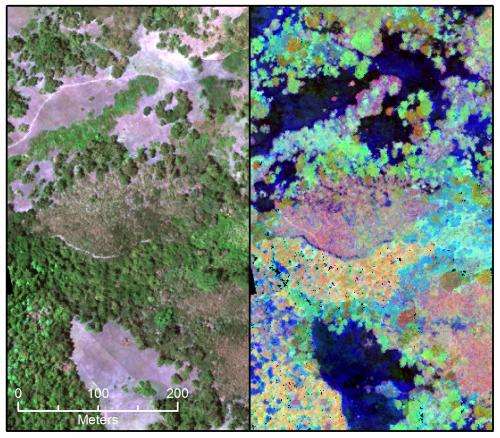Surprising predictor of ecosystem chemistry

Carnegie scientists have found that the plant species making up an ecosystem are better predictors of ecosystem chemistry than environmental conditions such as terrain, geology, or altitude. This is the first study using a new, high-resolution airborne, chemical-detecting instrument to map multiple ecosystem chemicals. The result, published in the April 8, 2013, Early Edition of the Proceedings of the National Academy of Sciences, is a key step toward understanding how species composition affects carbon, nitrogen and other nutrient cycling, and the effects of climate change, land use, and other ecosystem pressures.
Two important ecological goals are to understand the distribution and diversity of plants in their environment and how nutrients and energy flow through ecosystems. Both are essential to predict how the environment may change in the future, but untangling the relative importance of different influences has remained challenging.
Lead author Kyla Dahlin explained: "We used the high-resolution mapping capabilities of the Carnegie Airborne Observatory Airborne Taxonomic Mapping System (CAO AToMS), and found that the plant communities that make up Jasper Ridge Biological Preserve in Northern California were the strongest predictors. They explained 46% to 61% of the variation in plant chemical traits, and these traits hold the key to how ecosystems function."
The plant communities at Jasper Ridge include savanna/grasslands, evergreen oaks and chaparral, wetland ecosystems, and more. The researchers measured four traits mapped with CAO AToMS from the air: leaf nitrogen, leaf carbon, leaf water concentration, and canopy water content.
The researchers combined the airborne data with maps of known environmental regulators, such as terrain and geology, and maps of plant communities and land-use history to ask whether environmental conditions or plant communities were more indicative of the chemical variation of the vegetation. They found that environmental conditions played a role, but that plant communities were the stronger predictor.
Co-author Greg Asner, principal investigator of the CAO, commented, "The results are a powerful demonstration of the use of the latest airborne spectroscopic mapping techniques to understand the multiple chemicals in the foliage of vegetation, allowing us to relate the chemical information to biodiversity and environment. These are the tools of the future for ecological research and conservation science."
"This study is especially exciting for Carnegie because it answers questions about the roles of landscapes and plant communities that were posed by Carnegie investigators in the early decades of the 20th century," said co-author Chris Field, director of the Department of Global Ecology.
Journal information: Proceedings of the National Academy of Sciences
Provided by Carnegie Institution for Science

















